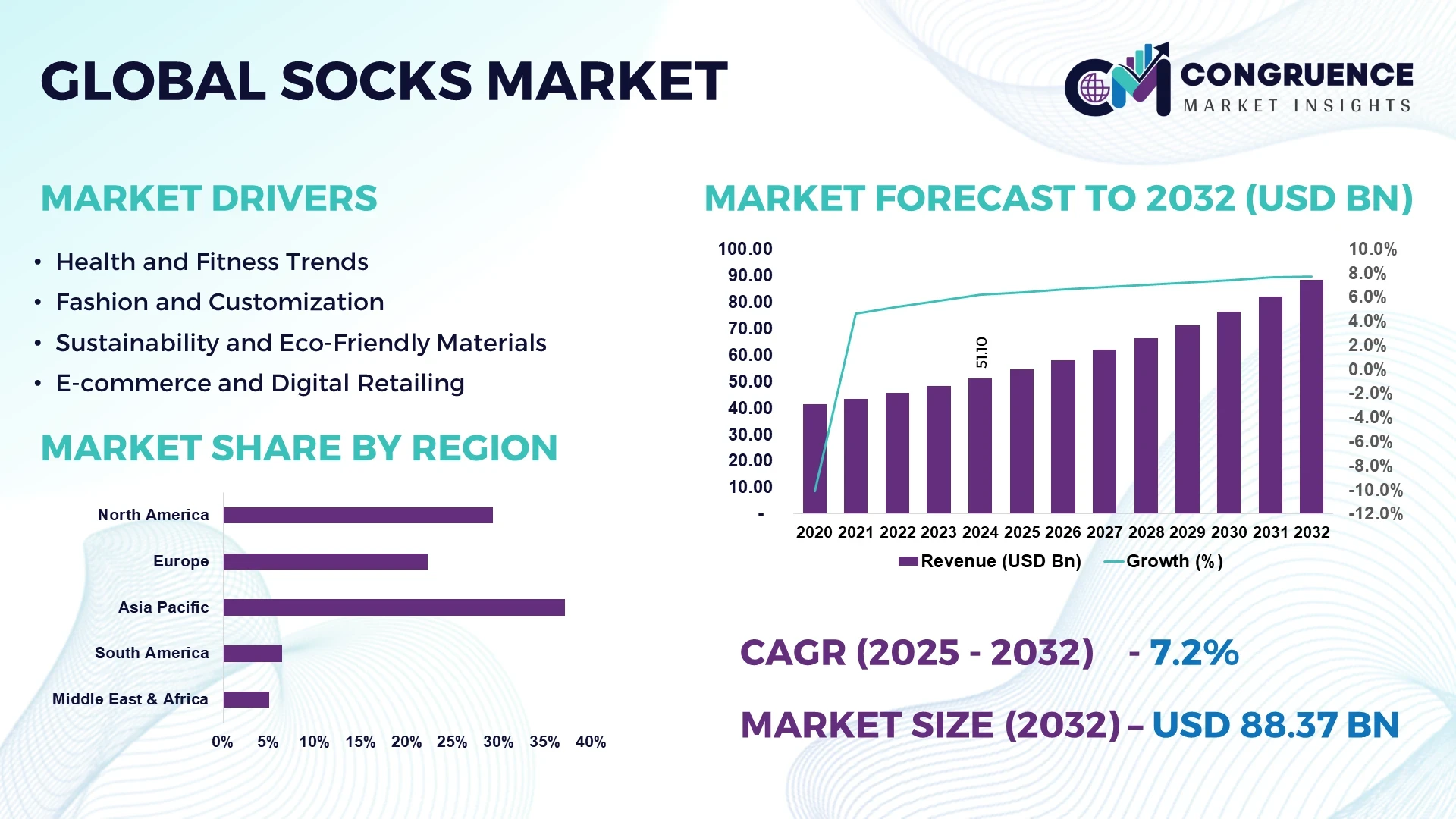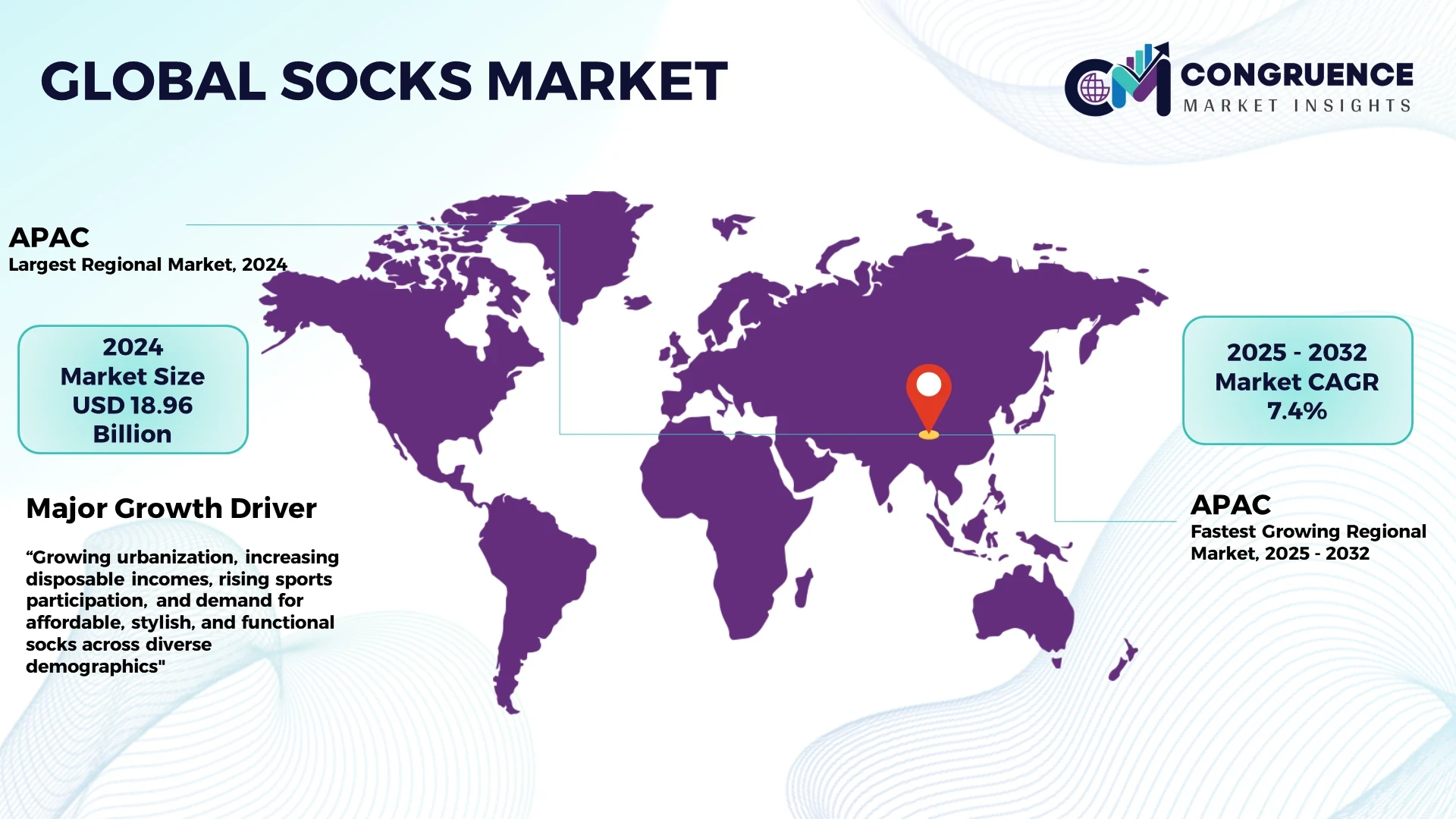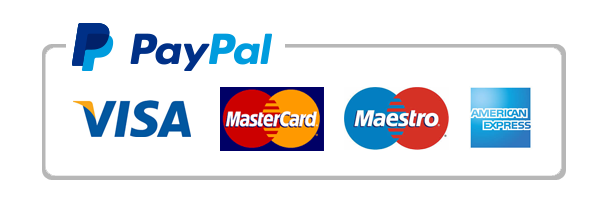Reports
Socks Market Size and Forecast 2025 to 2032
The Global Socks Market was valued at USD 51.10 Billion in 2024 and is anticipated to reach a value of USD 88.37 Billion by 2032 expanding at a CAGR of 7.2% between 2025 and 2032.

To Learn More About This Report, Request A Free Sample Copy
Socks are a daily necessity for a wide range of people, owing to rising health consciousness and a preference for luxury and performance-driven items. Specialized socks, such as compression and sports socks, are becoming increasingly popular among health-conscious customers and sportsmen. Furthermore, fashion-conscious consumers seek out new designs, which has led to the popularity of branded and customized socks. The rise of e-commerce and digital retail platforms has broadened the industry's reach, allowing consumers to easily access a wide range of socks, hence driving market growth. The Asia Pacific region is the largest market, accounting for 37.1% of the worldwide market in 2024, driven by rising urbanization and changing consumer behavior.
The global socks market has grown steadily in recent years, owing to a variety of factors, including rising demand for comfortable, functional, and attractive socks. Socks are a vital aspect of everyday wear, appealing to clients of all ages, income levels, and geographies. Demand for specialist socks, such as compression socks for circulation and sports socks for improved performance, has increased as people become more conscious of their health and fitness. Fashion trends, particularly among younger consumers, have driven desire for more distinctive and stylish designs. Premium socks have grown in popularity due to technological breakthroughs in materials and manufacturing techniques, such as moisture-wicking textiles and antibacterial treatments. As e-commerce platforms expand, online distribution of socks has increased dramatically, giving consumers more alternatives and simpler access. The Asia Pacific region dominates the market because to growing urbanization and rising disposable incomes, particularly in China and India.
How AI is Transforming Socks Market
Artificial intelligence (AI) is transforming the socks industry by increasing manufacturing efficiency, customizing customer experiences, and streamlining inventory management. AI-driven automation in production enables producers to produce socks faster and more precisely, lowering production costs and boosting product quality. AI is also being utilized to develop smart socks equipped with sensors that measure physical activity, foot pressure, and body temperature, making them popular among athletes and health-conscious consumers. These smart socks provide real-time data analysis and feedback, allowing wearers to improve their performance or monitor medical issues such as diabetes.
In addition to product innovation, retailers are using AI-powered recommendation engines to deliver tailored shopping experiences for their customers. These systems recommend personalized socks styles, sizes, and brands based on user preferences, purchasing history, and behavior, resulting in enhanced customer satisfaction and sales. Furthermore, AI-powered predictive analytics are streamlining inventory management and demand forecasting, allowing firms to ensure that they have enough stock to satisfy client demands while decreasing waste. As AI advances, it will play a critical role in altering the manufacture, marketing, and sale of socks, allowing businesses to remain competitive in the fast-paced fashion and apparel industries.
Socks Market Major Driving Forces
· Health and Fitness Trends: As people become more mindful of their health and fitness, there is a greater need for performance socks like compression and sports socks. Consumers are increasingly looking for socks that are comfortable, moisture-wicking, and supportive during athletic activity.
· Fashion and Customization: The fashion-forward generation has adopted socks as a statement piece. Consumers are eager to invest in fashionable and personalized socks, fueling demand for one-of-a-kind designs, patterns, and customizable alternatives, particularly among younger generations.
· Sustainability and Eco-Friendly Materials: As people become more concerned about the environment, there is a greater demand for organic and eco-friendly socks. Brands are increasingly selling socks made from recycled fibers and ecological textiles such as bamboo and organic cotton.
· E-commerce and Digital Retailing: The rise of e-commerce platforms has given consumers greater access to a wider range of products, allowing manufacturers to reach new customers. Online shopping convenience and direct-to-consumer companies have dramatically increased market penetration, especially in emerging nations.
Socks Market Key Opportunities
· Smart Sock Development: The rise of wearable technology has created considerable growth potential in the form of smart socks integrated with sensors for fitness tracking, foot pressure monitoring, and health diagnostics. These products are popular among athletes, healthcare providers, and tech-savvy customers.
· Sustainable Products: As customers become more ecologically conscious, the demand for eco-friendly and sustainable socks is likely to rise. Companies that use organic, biodegradable, and recycled products can capitalize on this increasing market area and cater to environmentally aware customers.
· Customized & Limited-Edition Socks: The trend of personalization allows brands to provide customizable sock designs. Companies can attract fashion-conscious customers looking for exclusive products by offering unique designs, colors, and limited-edition releases.
· Expansion in Emerging Markets: With increased urbanization, rising disposable incomes, and expanding internet access in emerging markets, businesses can take advantage of these chances to grow their consumer base by delivering affordable, trendy, and practical socks.
Socks Market Key Trends
· The athleisure trend is gaining steam, as more people incorporate sportswear into their everyday clothing. Performance and sports socks with moisture-wicking, anti-slip, and odor-resistant characteristics are in high demand.
· Companies are progressively releasing socks made from sustainable materials including bamboo, organic cotton, and recycled fibers. Ethical production practices are also becoming important factors for ecologically conscious consumers.
· As wearable technology advances, smart socks are becoming increasingly popular. These socks, which include sensors to measure movement and foot pressure, are especially useful in sports, healthcare, and rehabilitation situations.
· Online retail is playing an important part in increasing sales, with consumers preferring the ease of shopping for a wide range of sock options. Customization and direct-to-consumer strategies are gaining popularity, accelerating digital growth.
Region-wise Market Insights
Asia Pacific accounted for the largest market share at 37.1% in 2024 moreover, Asia Pacific is also expected to register the fastest growth, expanding at a CAGR of 7.4% between 2025 and 2032.

To Learn More About This Report, Request A Free Sample Copy
Rapid urbanization, an expanding middle class, and rising disposable incomes in nations like as China and India are propelling market expansion. Furthermore, the region's burgeoning e-commerce sector provides access to a diverse choice of economical and attractive socks, which drives up demand. On the other hand, North America has a sizable market share due to the increasing demand for luxury, performance-oriented socks. The burgeoning athleisure trend, combined with a more health-conscious population, is driving demand for specialized sports and compression socks in this region.
· In 2023, Puma partnered with sports leagues to supply team-branded performance socks, capitalizing on demand from fans and athletes for stylish yet functional sports socks.
· In 2022, Under Armour launched a new line of socks using compression technology to enhance performance and recovery, specifically targeting athletes and fitness enthusiasts.
In Europe, people want eco-friendly products and brands that follow ethical production standards. Germany and the United Kingdom dominate the market, with increased awareness of sustainable fashion options. Whereas, Latin America, the Middle East, and Africa are emerging markets, with rising consumer spending and increased access to multinational brands thanks to internet channels.
Recent Developments
· In 2023, Nike expanded its offerings of sustainable socks by introducing collections made from recycled polyester and organic cotton, aligning with the company’s sustainability initiatives under the "Move to Zero" campaign.
· In 2022, Adidas launched its "Primegreen" sock collection, made with high-performance recycled materials. The brand has been focusing on eco-friendly products and innovation in sports socks for high-performance athletes.
· In 2021, Hanesbrands introduced its “FreshIQ” technology in socks, designed to fight odors with advanced odor control solutions, providing consumers with added functionality and comfort.
Market Competition Landscape
The global socks market is highly competitive, with key players focusing on product innovation, sustainability, and expanding their online presence. Leading brands such as Nike, Inc., Adidas AG, Hanesbrands Inc., and Puma SE dominate the market, offering a wide range of athletic, casual, and specialty socks. Companies are increasingly adopting sustainable practices by using eco-friendly materials like organic cotton and recycled fibers, appealing to environmentally conscious consumers. Customization and limited-edition collections are also gaining traction among fashion-forward customers. Smaller players such as Bombas and Happy Socks focus on direct-to-consumer models and unique designs, capturing niche markets. The rise of e-commerce and growing demand for smart socks with embedded sensors for health monitoring present opportunities for both established brands and new entrants in this competitive landscape.
Key players in the global socks market implement various organic and inorganic strategies to strengthen and improve their market positioning. Prominent players in the market include:
· Nike, Inc.
· Adidas AG
· Hanesbrands Inc.
· Puma SE
· Under Armour, Inc.
· Falke KGaA
· Gildan Activewear Inc.
· Gold Toe Brands, Inc.
· Renfro Corporation
· Jockey International, Inc.
· Bombas, LLC
· Burlington Industries, LLC
· Happy Socks AB
· Stance, Inc.
|
Report Attribute/Metric |
Details |
|
Market Revenue in 2024 |
USD 51.10 Billion |
|
Market Revenue in 2032 |
USD 88.37 Billion |
|
CAGR (2025 – 2032) |
7.2% |
|
Base Year |
2024 |
|
Forecast Period |
2025 – 2032 |
|
Historical Data |
2020 to 2024 |
|
Forecast Unit |
Value (US$ Bn) |
|
Key Report Deliverable |
Revenue Forecast, Growth Trends, Market Dynamics, Segmental Overview, Regional and Country-wise Analysis, Competition Landscape |
|
Segments Covered |
· By Product Type: Athletic Socks, Casual Socks, Dress Socks, Compression Socks, No-Show Socks · By Material: Cotton, Wool, Nylon, Polyester, Bamboo · By End-User: Men, Women, Children, Unisex · By Distribution Channel: Online, Offline (Supermarkets/Hypermarkets, Specialty Stores, Convenience Stores) |
|
Geographies Covered |
North America: U.S., Canada and Mexico Europe: Germany, France, U.K., Italy, Spain, and Rest of Europe Asia Pacific: China, India, Japan, South Korea, Southeast Asia, and Rest of Asia Pacific South America: Brazil, Argentina, and Rest of Latin America Middle East & Africa: GCC Countries, South Africa, and Rest of Middle East & Africa |
|
Key Players Analyzed |
Nike, Inc., Adidas AG, Hanesbrands Inc., Puma SE, Under Armour, Inc., Falke KGaA, Gildan Activewear Inc., Gold Toe Brands, Inc., Renfro Corporation, Jockey International, Inc., Bombas, LLC, Burlington Industries, LLC, Happy Socks AB, Stance, Inc. |
|
Customization & Pricing |
Available on Request (10% Customization is Free) |
